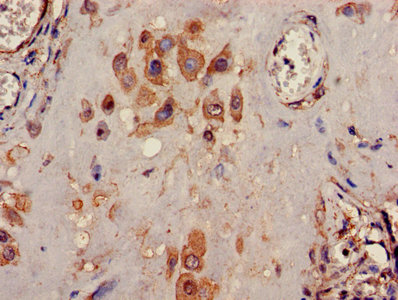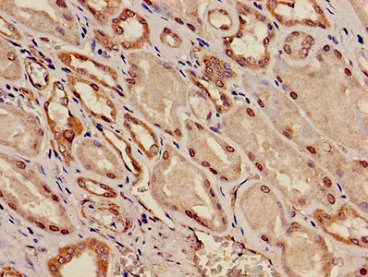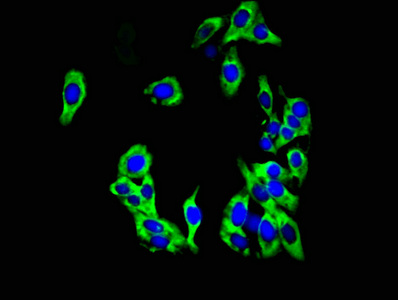KCNK1 Antibody
-
货号:CSB-PA012062LA01HU
-
规格:¥440
-
促销:
-
图片:
-
Immunohistochemistry of paraffin-embedded human placenta tissue using CSB-PA012062LA01HU at dilution of 1:100
-
Immunohistochemistry of paraffin-embedded human kidney tissue using CSB-PA012062LA01HU at dilution of 1:100
-
Immunofluorescent analysis of HepG2 cells using CSB-PA012062LA01HU at dilution of 1:100 and Alexa Fluor 488-congugated AffiniPure Goat Anti-Rabbit IgG(H+L)
-
-
其他:
产品详情
-
产品名称:Rabbit anti-Homo sapiens (Human) KCNK1 Polyclonal antibody
-
Uniprot No.:O00180
-
基因名:KCNK1
-
别名:KCNK1; HOHO1; KCNO1; TWIK1; Potassium channel subfamily K member 1; Inward rectifying potassium channel protein TWIK-1; Potassium channel K2P1; Potassium channel KCNO1
-
宿主:Rabbit
-
反应种属:Human
-
免疫原:Recombinant Human Potassium channel subfamily K member 1 protein (268-336AA)
-
免疫原种属:Homo sapiens (Human)
-
标记方式:Non-conjugated
本页面中的产品,KCNK1 Antibody (CSB-PA012062LA01HU),的标记方式是Non-conjugated。对于KCNK1 Antibody,我们还提供其他标记。见下表:
-
克隆类型:Polyclonal
-
抗体亚型:IgG
-
纯化方式:>95%, Protein G purified
-
浓度:It differs from different batches. Please contact us to confirm it.
-
保存缓冲液:Preservative: 0.03% Proclin 300
Constituents: 50% Glycerol, 0.01M PBS, pH 7.4 -
产品提供形式:Liquid
-
应用范围:ELISA, IHC, IF
-
推荐稀释比:
Application Recommended Dilution IHC 1:20-1:200 IF 1:50-1:200 -
Protocols:
-
储存条件:Upon receipt, store at -20°C or -80°C. Avoid repeated freeze.
-
货期:Basically, we can dispatch the products out in 1-3 working days after receiving your orders. Delivery time maybe differs from different purchasing way or location, please kindly consult your local distributors for specific delivery time.
相关产品
靶点详情
-
功能:Ion channel that contributes to passive transmembrane potassium transport and to the regulation of the resting membrane potential in brain astrocytes, but also in kidney and in other tissues. Forms dimeric channels through which potassium ions pass in accordance with their electrochemical gradient. The channel is selective for K(+) ions at physiological potassium concentrations and at neutral pH, but becomes permeable to Na(+) at subphysiological K(+) levels and upon acidification of the extracellular medium. The homodimer has very low potassium channel activity, when expressed in heterologous systems, and can function as weakly inward rectifying potassium channel. Channel activity is modulated by activation of serotonin receptors. Heterodimeric channels containing KCNK1 and KCNK2 have much higher activity, and may represent the predominant form in astrocytes. Heterodimeric channels containing KCNK1 and KCNK3 or KCNK9 have much higher activity. Heterodimeric channels formed by KCNK1 and KCNK9 may contribute to halothane-sensitive currents. Mediates outward rectifying potassium currents in dentate gyrus granule cells and contributes to the regulation of their resting membrane potential. Contributes to the regulation of action potential firing in dentate gyrus granule cells and down-regulates their intrinsic excitability. In astrocytes, the heterodimer formed by KCNK1 and KCNK2 is required for rapid glutamate release in response to activation of G-protein coupled receptors, such as F2R and CNR1. Required for normal ion and water transport in the kidney. Contributes to the regulation of the resting membrane potential of pancreatic beta cells. The low channel activity of homodimeric KCNK1 may be due to sumoylation. The low channel activity may be due to rapid internalization from the cell membrane and retention in recycling endosomes.
-
基因功能参考文献:
- Dynamics of the TWIK-1 Channel PMID: 27558721
- Our data indicate that TWIK-1 has a highly conserved role in cardiac function and is required for normal heart rate and atrial morphology. Despite the functional importance of TWIK-1 in the atrium, genetic variation in KCNK1 is not a common primary cause of human AF. PMID: 27103460
- TWIK-1 protein possesses a hydrophobic barrier deep within the inner pore PMID: 25001086
- Potassium channels, in particular K2P channels, are expressed and functional in the apical membrane of airway epithelial cells PMID: 21964404
- study presents the 3.4 angstrom resolution crystal structure of a human K2P channel, K2P1; an extracellular cap domain located above the selectivity filter forms an ion pathway in which K(+) ions flow through side portals PMID: 22282804
- ion selectivity of TWIK-1 K+ channels during pathological hypokalemia; a molecular basis for inward leak Na+ currents that could trigger or contribute to cardiac paradoxical depolarization in lowered [K+]o; mechanism for regulating cardiac excitability. PMID: 21653227
- TWIK1 is internalized via a dynamin-dependent mechanism and addressed to the recycling endosomal compartment. Mutation in its cytoplasmic C terminus (I293A,I294A) stabilizes TWIK1 at the plasma membrane, resulting in robust currents. PMID: 19959478
- Removal of the peptide adduct by SUMO protease reveals K2P1 to be a K+-selective, pH-sensitive, openly rectifying channel regulated by reversible peptide linkage. PMID: 15820677
- support TWIK-1 and TREK-1 as being the major components of the long-sought K(+) channels underlying the passive conductance of mature hippocampal astrocytes PMID: 19571146
显示更多
收起更多
-
亚细胞定位:Cell membrane; Multi-pass membrane protein. Recycling endosome. Cell junction, synapse, synaptic cell membrane. Cytoplasmic vesicle. Perikaryon. Cell projection, dendrite. Cell projection. Apical cell membrane; Multi-pass membrane protein.
-
蛋白家族:Two pore domain potassium channel (TC 1.A.1.8) family
-
组织特异性:Detected in bronchial epithelial cells. Detected in heart left atrium and left ventricle. Detected in cardiac myocytes (at protein level). Widely expressed with high levels in heart, brain and kidney, and lower levels in colon, ovary, placenta, lung and l
-
数据库链接:
HGNC: 6272
OMIM: 601745
KEGG: hsa:3775
STRING: 9606.ENSP00000355580
UniGene: Hs.208544
Most popular with customers
-
-
YWHAB Recombinant Monoclonal Antibody
Applications: ELISA, WB, IF, FC
Species Reactivity: Human, Mouse, Rat
-
-
-
-
-
-
























